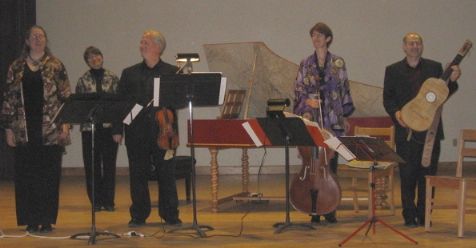|
Choral and Vocal
CANTIAMO SONOMA SINGS AN INSPIRED GOOD FRIDAY MOZART REQUIEM CONCERT
by Pamela Hicks Gailey
Friday, April 18, 2025
Symphony
DRAMATIC SHOSTAKOVICH SYMPHONY CLOSES PHILHARMONIC'S 25TH SEASON
by Terry McNeill
Sunday, April 13, 2025
Recital
LARGE COLLEGE OF MARIN AUDIENCE GREETS STOPHER ARTISTRY
by Terry McNeill
Saturday, April 5, 2025
Chamber
FRISSON DELIVERS SHIVERS OF DELIGHT
by Abby Wasserman
Sunday, March 30, 2025
Chamber
THE PARKER CAPTURES DEMANDING ADES QUARTET AT RAC SEBASTOPOL CONCERT
by Peter Lert
Saturday, February 15, 2025
SPLENDID ECHOES ACROSS THE BAY
by Abby Wasserman
Sunday, February 9, 2025
ETHEREAL DUO IN WEILL HALL RECITAL
by Pamela Hicks Gailey
Thursday, February 6, 2025
ESPANA SEGURO AT SO CO PHIL'S JACKSON THEATER CONCERT
by Terry McNeill
Sunday, February 2, 2025
Choral and Vocal
MASTERFUL SINGING CLASS IN SCHROEDER HALL
by Pamela Hicks Gailey
Sunday, February 2, 2025
Recital
MUSICAL POT POURRI AT SPRING LAKE VILLAGE RECITAL
by Terry McNeill
Friday, January 31, 2025
|
 |
 Francis Blaker, Henneke Van Proosdij, David Wilson, Barbara Blaker Krumdieck and William Simms |
ENSEMBLE VERMILLIAN ADDS A THEORBO IN JAN. 8 WALDORF SCHOOL CONCERT
by Joanna Bramel Young
Saturday, January 8, 2011
The Ensemble Vermillian performed an exquisite concert Jan. 8 of both early and high Baroque delights at Summerfield Waldorf School in Santa Rosa. The ensemble likes to explore less-familiar works of the early Baroque (about 1600 – 1700), but in this concert they also included works by the great High Baroque composers Bach and Telemann.
The ensemble has expanded their repertoire to include transcriptions of works written for other instruments, a common custom during this period. Composers often assumed their works would be performed by a variety of different instruments. One example of this practice is the Bach Trio Sonata played by the Vermillian – written for organ, but re-arranged for recorder, violin, harpsichord and cello (the harpsichord and cello being “one” voice). Bach himself often made arrangements of his own works for different combinations of instruments, an example being the Fourth Brandenburg Concerto arranged for two recorders and harpsichord. The Bach Trio Sonata No. 5 brought out the three separate voices, which on the organ would have been for right hand, left hand and pedal. There was a wonderful interaction among the three voices, clarifying the contrapuntal structure of the piece.
Unlike the usual early music ensemble of two solo voices, cello and harpsichord, Ensemble Vermillian has added a theorbo and baroque guitar to the mix. The theorbo is also called an arch lute (or baroque lute), its large lute body connected to a six foot long fingerboard with an impressive array of strings, going from high to extremely low. The theorbo, according to performer William Simms, has lower strings than the arch lute. Mr. Simms chose one or the other instrument, depending on the requirements of the piece. They enhanced the rhythmic structure with strumming and plucking of notes. These two instruments added a captivating visual as well as audible dimension to the early Baroque works.
Frances Blaker demonstrated a complete mastery of several recorders and chose demanding and virtuosic works, full of sudden runs and quick changes of tempo. She and violinist David Wilson demonstrated the flexibility and brilliance of their playing on works by Buxtehude and Bertali. This reviewer was particularly impressed by the fine intonation among all the instruments. Mr. Wilson performed a Biber sonata for violin and basso continuo that showcased the brilliance of his technique. Called “Annunciation,” this sonata was from the “Rosary Sonatas” collection. The work was a piece of early program music, the violin creating the effect of the fluttering of angelic wings as the angel arrives to talk to the Virgin Mary. You can hear the angel land, and then a conversation ensues between the two, then the angel leaves. Very charming.
Hanneke van Proosdij is one of those rare people who can claim mastery of the harpsichord, organ and the recorder. This evening she demonstrated only one of these talents, the harpsichord, playing a Bach Toccata. The work began with a free prelude, and then launched into a great fugue. It was a long and richly varied piece, played on different registers of her magnificent vermillian harpsichord. Ms. van Proosdij plays with a variety of articulation, contrasting the driving rhythms of the fugue with the very free interpretation of other parts of the work. The word “toccata” means a composition intended to demonstrate the touch and execution of the performer, something the artist did admirably.
The concert ended with a very rousing and rhythmical renaissance dance by Giovanni Battista Buonamente, who lived from c.1595 to 1642. Although technically straddling the Renaissance and Baroque periods, this work appeared to this reviewer to be very much in the late renaissance tradition. The “Ballo del Gran Duca” was performed on soprano recorder, violin, guitar, cello and harpsichord. The intricate cross rhythms had everyone in the audience tapping their feet with the bright strumming of the guitar adding its special effect.
This was a thoroughly enjoyable concert, full of variety and fresh sounds.
|

